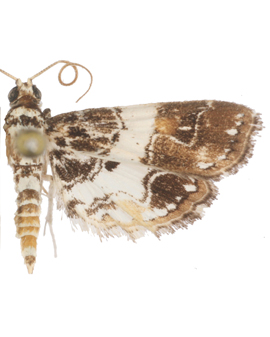Paracymoriza albifascialis Hampson, [1893]; PED 3

-
Taxonomy
The type of Parthenodes albifascialis Hampson, 1891: p.140, Pl. 156, figs 1, 9). from India (Assam) is in the NHM. Comb. n. to Paracymoriza (Yoshiyasu, 1987: 149).
Syn. Hydrocampa phlegetonalis Snellen, 1895: 155, pl. 6, fig. 9, 10.. TL Java. The type is in Leiden. Syn n. as a junior subjective synonym of P. albifascialis Hampson 1893 (Speidel & Mey, 1999) -
Description
Wing length: 10mm. The sp. is dimorphic with the males having a broad white FW median band. Originally named as Hydrocampa phlegetonalis by Snellen. The females have a mainly dark brown FW with some white fasciation and patches. Typically male and females have a similar HW. The sp. is somewhat variable in the amount and shade of dark colouration and the size of the HW spot. The majority of specimens seen in museums are females
-
Distribution & Habitat
India (Assam, Tamilnadu), Thailand, W.Malaysia, Sabah, Sarawak, Indonesia (Java, Sumatra) Lowland and hill primary and secondary forest and cultivated areas; <1300m.
-
Life History & Pest Status
The egg clusters of Eooophyla, Strepsinoma and Paracymoriza are laid on the surface of rocks in rivers and streams (Yen 2004). The larvae feed on aquatic mosses or algae in rapid streams or brackish water
-
Similar spp.
No content available.
-
Unrelated Look-alikes
No content available.
-
References
Hampson,G.F. (1891) Illustrations of typical specimens of Lepid. Heteroc. coll. B.M., 8. The Lepidoptera Heterocera of the Nilgiri district. 144 pp., pl. 139-156. London. [RTS] (1994): 166, pl. 28, fig.11.
Yoshiyasu, Y., (1987) The Nymphulinae (Lepidoptera: Pyralidae) from Thailand, with descriptions of a new genus and six new species. – In Kuroko, H. & Moriuti, S. (eds.) Microlepidoptera of Thailand 1: 133-184.
Snellen, P. C. T., (1895) Aanteekeningen over Pyraliden. Tijdschr. v. Ent. 38: 155, pl. 6, fig. 9, 10. -
Genitalia
No content available.
-
DNA Barcode
No content available.
-
3D Imaging
No content available.
-
Spare
No content available.
KEY TO TABS
(1) Taxonomy, (2) Description, (3) Distribution & Habitat, (4) Life History & Pest Status, (5) Similar spp., (6) Unrelated Look-alikes, (7) References, (8) Genitalia, (9) DNA Barcode, (10) 3D Imaging, (11) Spare

